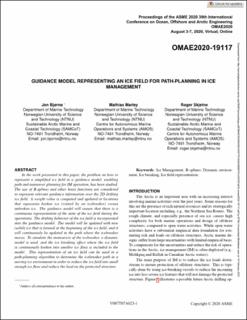| dc.contributor.author | Bjørnø, Jon | |
| dc.contributor.author | Marley, Mathias | |
| dc.contributor.author | Skjetne, Roger | |
| dc.date.accessioned | 2021-02-16T09:41:31Z | |
| dc.date.available | 2021-02-16T09:41:31Z | |
| dc.date.created | 2021-01-06T19:14:18Z | |
| dc.date.issued | 2020 | |
| dc.identifier.isbn | 978-0-7918-8439-3 | |
| dc.identifier.uri | https://hdl.handle.net/11250/2728277 | |
| dc.description.abstract | In the work presented in this paper, the problem on how to represent a simplified ice field in a guidance model, enabling path and maneuver planning for IM operation, has been studied. The use of B-splines and other basis functions are considered to represent relevant guidance information over the 2D drifting ice field. A weight value is computed and updated at locations that represents broken ice (visited by an icebreaker) versus unbroken ice. The guidance model will ensure that there is a continuous representation of the state of the ice field during the operations. The drifting behavior of the ice field is incorporated into the guidance model. The model will be updated with new (solid) ice that is formed at the beginning of the ice field, and it will continuously be updated in the path where the icebreaker moves. To simulate the maneuvers of the icebreaker, a dynamic model is used, and the ice breaking effect where the ice field is continuously broken into smaller ice floes is included in the model. This representation of an ice field can be used in a path-planning algorithm to determine the icebreaker path in a moving ice environment in order to reduce the ice field into small enough ice floes and reduce the load on the protected structure. | en_US |
| dc.language.iso | eng | en_US |
| dc.publisher | ASME | en_US |
| dc.relation.ispartof | ASME 2020 39th International Conference on Ocean, Offshore and Arctic Engineering - Volume 7: Polar and Arctic Sciences and Technology | |
| dc.relation.uri | https://asmedigitalcollection.asme.org/OMAE/proceedings-pdf/OMAE2020/84393/V007T07A023/6606751/v007t07a023-omae2020-19117.pdf | |
| dc.title | Guidance Model Representing an Ice Field for Path-Planning in Ice Management | en_US |
| dc.type | Chapter | en_US |
| dc.description.version | publishedVersion | en_US |
| dc.identifier.doi | 10.1115/OMAE2020-19117 | |
| dc.identifier.cristin | 1866642 | |
| dc.relation.project | Norges forskningsråd: 203471 | en_US |
| dc.relation.project | Norges forskningsråd: 223254 | en_US |
| dc.description.localcode | Locked until 18.6.2021 due to copyright restrictions. Copyright © 2020 by ASME | en_US |
| cristin.ispublished | true | |
| cristin.fulltext | postprint | |
| cristin.qualitycode | 1 | |
